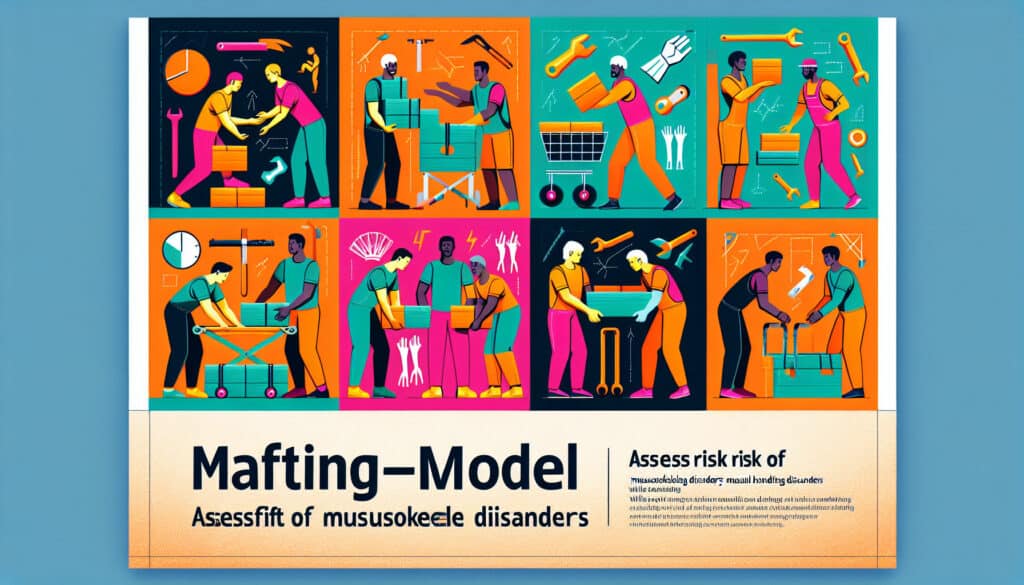A model for assessing the risk of musculoskeletal disorders associated with manual handling tasks.
- Metodologías: Clientes y marketing, Economía
Lifting-Moving-Model (LMM)

Lifting-Moving-Model (LMM)
- Mejora continua, Diseño para la fabricación (DfM), Ergonomía, Human Factors, Ingeniería de factores humanos (HFE), Mejora de procesos, Análisis de riesgos, Gestión de riesgos, Seguridad
Objetivo:
Cómo se utiliza:
- A model that is used to assess the risk of musculoskeletal disorders associated with lifting and moving tasks. It takes into account a number of factors, such as the weight of the object, the distance it is moved, and the posture of the worker.
Ventajas
- Provides a quantitative measure of risk; Can be used to compare the risk of different tasks.
Contras
- Can be complex to use and may require specialized software; May not be as accurate as a full ergonomic assessment.
Categorías:
- Ergonomía, Gestión de riesgos
Ideal para:
- Assessing the risk of lifting and moving tasks to prioritize for further evaluación ergonómica.
The Lifting-Moving-Model (LMM) methodology serves as a valuable tool for industries where manual handling of objects is prevalent, such as warehousing, construction, healthcare, and manufacturing. It is particularly beneficial during the design and assessment phases of task workflows, where ergonomic evaluations can significantly influence modifications that enhance worker safety and productivity. Participants in this process may include ergonomists, safety engineers, production managers, and occupational health specialists who collectively analyze lifting and moving tasks to identify risks associated with musculoskeletal disorders. The methodology encourages data collection on various factors, including load weight, duration of task exposure, and worker posture, enabling quantitative risk assessments that allow organizations to prioritize interventions effectively. LMM can be applied not only for evaluating existing tasks but also when designing new operations or workstations, ensuring that ergonomics is integrated from the beginning of the design process. This results in lowered injury rates, improved compliance with safety regulations, and can lead to potential cost savings by reducing workers’ compensation claims and increasing overall efficiency. Industries adopting LMM can benefit from its comparative risk analysis capabilities, allowing them to evaluate and improve the ergonomics of multiple tasks systematically.
Pasos clave de esta metodología
- Identify and define the lifting and moving tasks to be assessed.
- Determine the weight of the object being lifted or moved.
- Measure the horizontal and vertical distance of the lift or move.
- Assess the posture of the worker during the task, noting angles of joints.
- Evaluate the frequency and duration of the lifting or moving task.
- Calculate the Lifting-Moving-Model risk score using established formulas.
- Rank tasks based on the calculated risk scores for prioritization.
Consejos profesionales
- Incorporate real-time monitoring technologies, such as wearable sensors, to capture dynamic data on lifting mechanics and worker postures, enhancing the precision of LMM applications.
- Perform sensitivity analyses using LMM to identify which variables exert the most influence on risk outcomes and target those for ergonomic interventions effectively.
- Leverage comparative risk assessment by applying LMM to historical task data, enabling prioritization of high-risk tasks for redesign or training interventions.
Leer y comparar varias metodologías, recomendamos el
> Amplio repositorio de metodologías <
junto con otras más de 400 metodologías.
Sus comentarios sobre esta metodología o información adicional son bienvenidos en la dirección sección de comentarios ↓ , así como cualquier idea o enlace relacionado con la ingeniería.
Contexto histórico
1986
(si se desconoce la fecha o no es relevante, por ejemplo "mecánica de fluidos", se ofrece una estimación redondeada de su notable aparición)

Publicaciones relacionadas
Cuestionarios sobre molestias musculoesqueléticas
Pruebas multivariantes (MVT)
Análisis de regresión múltiple
Sistemas de captura de movimiento
Método MoSCoW
Prueba de la mediana de Mood